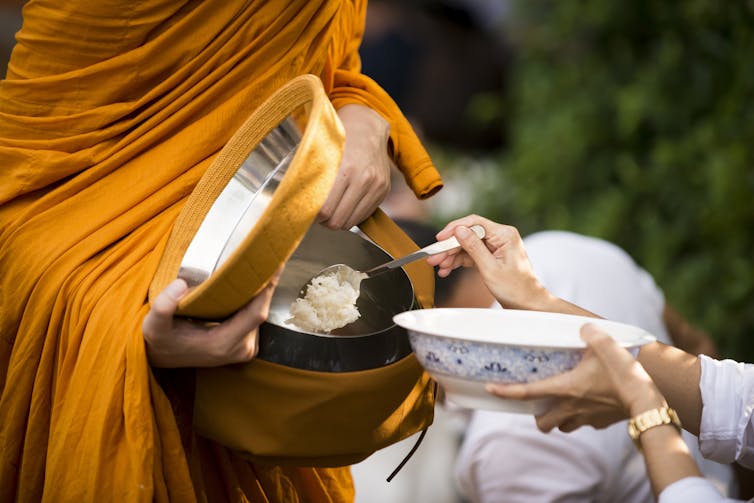
Theravada, which means “the way of the elders,” is one of the two main schools of Buddhism. Its adherents consider Theravada to be the most authoritative branch because they believe their teachings come directly from the historical Buddha.
As a scholar of Buddhism, I explain in my 2023 book “Living Theravada: Demystifying the People, Places and Practices of a Buddhist Tradition” that Theravada Buddhism has a number of distinguishing features.
Its canonical literature is preserved in the ancient language of Pali, while other branches use Sanskrit, Chinese and Tibetan. An important ritual for Theravada monks includes collecting alms every morning. Another feature is that young men can enter into monastic life for a short time and return to lay life. Most often they do this as young boys, but a male at any age can become ordained for any length of time.
Early development
A combination of factors helped Theravada Buddhism take root first in Sri Lanka and then mainland Southeast Asia: Buddhism arrived in the region from India in the second century B.C.E. through the teachings of pilgrims, traveling monks and scholars who impressed local populations with the cosmopolitan nature of Buddhist culture.
Kings and kingdoms became deeply engaged with those ideas. Buddhism gave rulers a cosmic framework in which the kings had a central place and carried the responsibility to protect and support the Buddhist teachings. Monks acted as advisers and supporters to monarchs because the monastic institution depended on the success and sponsorship of the royalty.

Besides monks, lay people could become involved with Buddhism in various ways. Women especially were valued as caregivers who supported the monastery through material offerings.
As Theravada became the dominant religious system within parts of South and Southeast Asia, it encompassed older Indigenous spirit traditions rather than degrading or purging them. This adaptation rather than competition allowed for Theravada Buddhism to become a cultural force in these regions.
The scriptures
The Pali Canon, which records what are believed to be the Buddha’s words, is divided into three parts, called the Tipitaka, or the Three Baskets: (1) the Sutta Pitaka, collections of stories and poetry expressing the Buddha’s teachings; (2) the Vinaya Pitaka, stories and discussions regarding the rules of monks; and (3) the Abhidhamma Pitaka, the philosophical and metaphysical explanation of Buddhist teachings and concepts.
These texts passed through oral recitation and memory shortly after the Buddha’s death, around the fifth century B.C.E. At that time the oral canon is believed to have been established with a gathering of 500 enlightened monks at the First Buddhist Council, held in modern-day India. By the first century B.C.E., the Pali Canon formed a fixed collection of written texts.
Diversity in the tradition
Practitioners following the Theravada tradition form part of the Buddhist diaspora throughout the world, but countries with a majority population of Theravada Buddhists live in Cambodia, Laos, Myanmar, Sri Lanka and Thailand.
Within these countries there is a rich diversity of traditions in Theravada Buddhism. Myanmar is known for popularizing a form of meditation called vipassana, or insight meditation; Thai Buddhists are considered to be holders of the orthodox tradition through their preservation of the monastic rules; Cambodia has a reputation for magical and supernatural expertise; Lao Buddhism is closely connected to spirits; and Sri Lankan religious practice is integrated with Hindu gods and demons.
These distinctions only begin to reveal a rich diversity of traditions underneath the surface. Theravada Buddhist beliefs and practices are more than monastic lineages and meditation techniques. The tradition offers a spectrum of spiritual resources to accommodate a variety of people’s wants, needs and aspirations.
Brooke Schedneck does not work for, consult, own shares in or receive funding from any company or organization that would benefit from this article, and has disclosed no relevant affiliations beyond their academic appointment.
This article was originally published on The Conversation. Read the original article.







